Johann Pachelbel was a German composer, organist, and teacher who brought the south German organ schools to their peak. He composed a large body of sacred and secular music, and his contributions to the development of the chorale prelude and fugue have earned him a place among the most important composers of the middle Baroque era.
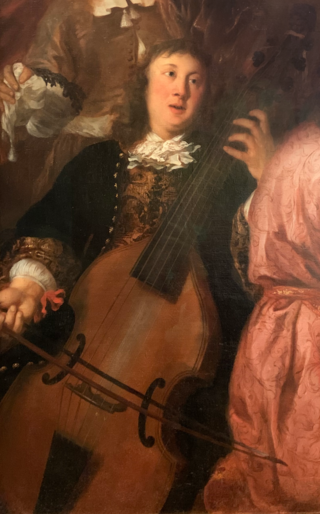
Dieterich Buxtehude was a Danish organist and composer of the Baroque period, whose works are typical of the North German organ school. As a composer who worked in various vocal and instrumental idioms, Buxtehude's style greatly influenced other composers, such as Johann Sebastian Bach and George Frideric Handel. Buxtehude is considered one of the most important composers of the 17th century.

A chaconne is a type of musical composition often used as a vehicle for variation on a repeated short harmonic progression, often involving a fairly short repetitive bass-line which offers a compositional outline for variation, decoration, figuration and melodic invention. In this it closely resembles the passacaglia. It originates and was particularly popular in the Baroque era; a large number of Chaconnes exist from the 17th- and 18th- centuries.
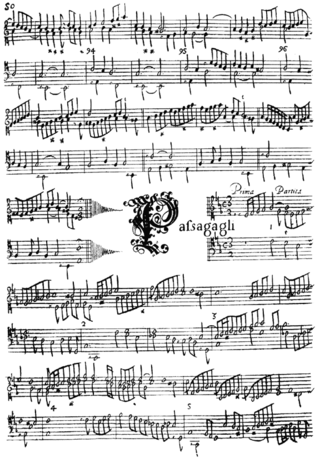
The passacaglia is a musical form that originated in early seventeenth-century Spain and is still used today by composers. It is usually of a serious character and is typically based on a bass-ostinato and written in triple metre.

The Toccata and Fugue in D minor, BWV 565, is a composition for organ by, according to the oldest sources, German composer Johann Sebastian Bach and is one of the most widely recognisable works in the organ repertoire. Although the date of its origin is unknown, scholars have suggested between 1704 and the 1750s. The piece opens with a toccata section followed by a fugue that ends in a coda, and is largely typical of the north German organ school of the Baroque era.

The sonatas and partitas for solo violin are a set of six works composed by Johann Sebastian Bach. They are sometimes referred to in English as the sonatas and partias for solo violin in accordance with Bach's headings in the autograph manuscript: "Partia" was commonly used in German-speaking regions during Bach's time, whereas the Italian "partita" was introduced to this set in the 1879 Bach Gesellschaft edition, having become standard by that time. The set consists of three sonatas da chiesa in four movements and three partitas in dance-form movements. The 2nd Partita is widely known for its Chaconne, considered one of the most masterly and expressive works ever written for solo violin.

The Partita in D minor for solo violin by Johann Sebastian Bach was written between 1717 and 1720. It is a part of his compositional cycle called Sonatas and Partitas for Solo Violin.
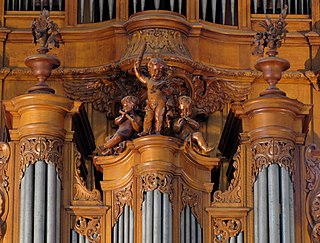
The Eight Short Preludes and Fugues, BWV 553–560, are a collection of works for keyboard and pedal formerly attributed to Johann Sebastian Bach. They are now believed to have been composed by one of Bach's pupils, possibly Johann Tobias Krebs or his son Johann Ludwig Krebs, or by the Bohemian composer Johann Caspar Ferdinand Fischer.

Toccata, Adagio, and Fugue in C major is an organ composition by Johann Sebastian Bach. As is the case with most other organ works by Bach, the autograph score does not survive. The earliest manuscript copies were probably made in 1719–1727. The title of the piece in these copies is given, as expected of organ literature of the time, simply as Toccata in C major. The piece is an early work, probably composed in the mid-to-late Weimar years, i.e. 1710–1717. It shares some similarities with other toccatas composed around the same time, such as BWV 538, BWV 540, and others: all show the influence of concerto style and form.
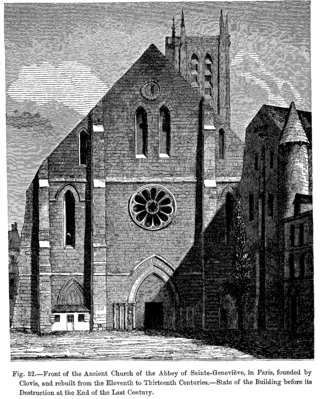
André Raison was a French Baroque composer and organist. During his lifetime he was one of the most famous French organists and an important influence on French organ music. He published two collections of organ works, in 1688 and 1714. The first contains liturgical music intended for monasteries and a preface with information on contemporary performance practice. The second contains mostly noëls.
Prelude (Toccata) and Fugue in E major, BWV 566 is an organ work written by Johann Sebastian Bach probably during his 4 month-stay at Lübeck or afterwards in the winter of 1705–1706. It comprises five sections and is an early work in grand form of Bach.
Wolfgang Friedrich Rübsam is a German-American organist, pianist, composer and pedagogue.

Johann Sebastian Bach was a German composer and musician of the late Baroque period. He is known for his prolific authorship of music across a variety of instruments and forms, including; orchestral music such as the Brandenburg Concertos; solo instrumental works such as the cello suites and sonatas and partitas for solo violin; keyboard works such as the Goldberg Variations and The Well-Tempered Clavier; organ works such as the Schubler Chorales and the Toccata and Fugue in D minor; and choral works such as the St Matthew Passion and the Mass in B minor. Since the 19th-century Bach Revival, he has been generally regarded as one of the greatest composers in the history of Western music.
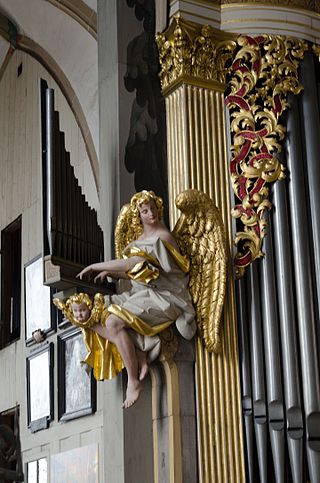
Prelude and Fugue in A minor, BWV 543 is a piece of organ music written by Johann Sebastian Bach sometime around his years as court organist to the Duke of Saxe-Weimar (1708–1713).
Fugue in G minor, BWV 578,, is a piece of organ music written by Johann Sebastian Bach during his years at Arnstadt (1703–1707). It is one of Bach's best known fugues and has been arranged for other voices, including an orchestral version by Leopold Stokowski.
Passacaglia in D minor is an organ work by Dieterich Buxtehude. It is generally acknowledged as one of his most important works, and was possibly an influence on Bach's Passacaglia and Fugue in C minor, as well as Brahms' music.
Chaconne in D minor is an organ chaconne by Johann Pachelbel. It is one of the six surviving chaconnes by the composer, and one of his best known organ works.
Chaconne in F minor is an organ chaconne by Johann Pachelbel. One of the six surviving chaconnes by the composer, it is one of his best known organ works.

The organ sonatas, BWV 525–530 by Johann Sebastian Bach are a collection of six sonatas in trio sonata form. Each of the sonatas has three movements, with three independent parts in the two manuals and obbligato pedal. The collection was put together in Leipzig in the late 1720s and contained reworkings of prior compositions by Bach from earlier cantatas, organ works and chamber music as well as some newly composed movements. The sixth sonata, BWV 530, is the only one for which all three movements were specially composed for the collection. When played on an organ, the second manual part is often played an octave lower on the keyboard with appropriate registration. Commentators have suggested that the collection might partly have been intended for private study to perfect organ technique, some pointing out that its compass allows it to be played on a pedal clavichord. The collection of sonatas is generally regarded as one of Bach's masterpieces for organ. The sonatas are also considered to be amongst his most difficult compositions for the instrument.














